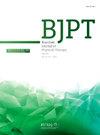Non-linear interactions among hip and foot biomechanical factors predict foot pronation during walking in women
IF 3.2
3区 医学
Q1 ORTHOPEDICS
引用次数: 0
Abstract
Background
Interactions between hip and foot biomechanical factors may result in different magnitudes of foot pronation during walking.
Objective
To investigate non-linear interactions between hip and foot biomechanical factors and their capability to predict foot pronation during walking and identify the profiles of biomechanical factors that predict greater and lower pronation.
Methods
This is a cross-sectional study. Fifty-one women were classified into greater and lower foot pronation during walking. Biomechanical factors measured: (1) foot-ankle varus alignment, (2) hip passive stiffness, (3) isokinetic eccentric strength of hip external rotators, and (4) foot abduction angle. Classification and regression trees (CART) were used to investigate non-linear interactions that predict greater and lower foot pronation.
Results
Four main profiles of biomechanical factors were identified as related to greater and lower foot pronation. Profiles for greater pronation were: (1) varus >25.83°; (2) interaction between varus ≤25.83° and hip stiffness ≤0.09 Nm/rad kg-1; (3) interaction between varus ≤25.83°, hip stiffness >0.09 Nm/rad kg-1, and foot abduction >19.58° The profile for lower pronation involved an interaction among varus ≤25.83°, hip stiffness >0.09 Nm/rad kg-1, and foot abduction ≤19.58° The model had 61 % sensitivity and 96 % specificity, with the total prediction of 78 %. The area under the ROC curve was 0.79 (p = 0.001).
Conclusion
Foot-ankle varus, hip passive stiffness, and foot abduction predicted greater and lower foot pronation. Non-linear interactions between hip and foot factors influence the magnitude of foot pronation during walking. The observed profiles help identify which combinations of biomechanical factors should be assessed in individuals with increased or reduced pronation.
髋部和足部生物力学因素之间的非线性相互作用可预测女性行走时足部的前倾。
背景髋部和足部生物力学因素之间的相互作用可能会导致行走时足部前伸的不同幅度:研究髋关节和足部生物力学因素之间的非线性相互作用及其预测步行时足部前倾的能力,并确定预测较大和较小前倾的生物力学因素的轮廓:这是一项横断面研究。方法:这是一项横断面研究,51 名女性在行走时被分为足前倾较大和较小两种情况。测量的生物力学因素包括:(1)足踝屈曲对齐;(2)髋关节被动僵硬度;(3)髋关节外旋肌的等速偏心力量;(4)足外展角度。分类和回归树(CART)用于研究预测足外翻较大和较小的非线性相互作用:结果:确定了与足前倾较大和较小有关的四个主要生物力学因素。足前倾幅度较大的因素有(1) 曲度>25.83°;(2) 曲度≤25.83°与髋关节僵硬度≤0.09牛米/拉德公斤-1之间的相互作用;(3) 曲度≤25.83°、髋关节僵硬度>0.09牛米/拉德公斤-1和足外展>19.58°之间的相互作用。该模型的灵敏度为 61%,特异度为 96%,总预测率为 78%。ROC 曲线下面积为 0.79(P = 0.001):结论:足踝外翻、髋关节被动僵硬度和足外展可预测较大和较小的足前伸。髋关节和足部因素之间的非线性相互作用影响着行走时足部前伸的幅度。观察到的特征有助于确定应评估哪些生物力学因素组合会导致足前倾增加或减少。
本文章由计算机程序翻译,如有差异,请以英文原文为准。
求助全文
约1分钟内获得全文
求助全文
来源期刊
CiteScore
6.10
自引率
8.80%
发文量
53
审稿时长
74 days
期刊介绍:
The Brazilian Journal of Physical Therapy (BJPT) is the official publication of the Brazilian Society of Physical Therapy Research and Graduate Studies (ABRAPG-Ft). It publishes original research articles on topics related to the areas of physical therapy and rehabilitation sciences, including clinical, basic or applied studies on the assessment, prevention, and treatment of movement disorders.

 求助内容:
求助内容: 应助结果提醒方式:
应助结果提醒方式:


